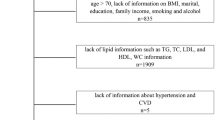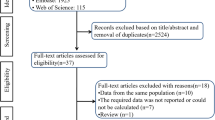Abstract
It is unclear whether high blood pressure per se or antihypertensive drug use causes erectile dysfunction (ED). The aim of this study was to investigate the effect of cardiovascular diseases and their concomitant medications use on the incidence of ED. The target population consisted of men aged 55, 65 or 75 years old residing in the study area in Finland in 1999. Questionnaires were mailed to 2837 men in 1999 and to 2510 of them 5 years later. The follow-up sample consisted of 1665 men (66% of those eligible) who responded to both baseline and follow-up questionnaires. Men free of moderate or severe ED at baseline (N=1000) were included in the study. ED was assessed by two questions on subject ability to achieve or maintain an erection sufficient for intercourse. Poisson regression model was used in the multivariable analyses. The risk of ED was higher in men suffering from treated hypertension or heart disease than in those with the untreated condition. The risk of ED was higher in men using calcium channel inhibitor (adjusted relative risk (RR)=1.6, 95% confidence interval (CI) 1.0–2.4), angiotensin II antagonist (RR=2.2, 95% CI 1.0–4.7), non-selective β-blocker (RR=1.7, 95% CI 0.9–3.2) or diuretic (RR=1.3, CI 0.7–2.4) compared with non-users. ED was not associated with using organic nitrates, angiotensin-converting enzyme inhibitors, selective β-blockers and serum lipid-lowering agents. In summary, calcium channel inhibitors, angiotensin II antagonists, non-selective β-blockers and diuretics may increase the risk of ED.
This is a preview of subscription content, access via your institution
Access options
Subscribe to this journal
Receive 8 print issues and online access
$259.00 per year
only $32.38 per issue
Buy this article
- Purchase on Springer Link
- Instant access to full article PDF
Prices may be subject to local taxes which are calculated during checkout
Similar content being viewed by others
References
Feldman HA, Goldstein I, Hatzichristou DG, Krane RJ, McKinlay JB . Impotence and its medical and psychosocial correlates: results of the Massachusetts Male Aging Study. J Urol 1994; 151: 54–61.
Johannes CB, Araujo AB, Feldman HA, Derby CA, Kleinman KP, McKinlay JB . Incidence of erectile dysfunction in men 40 to 69 years old: longitudinal results from the Massachusetts male aging study. J Urol 2000; 163: 460–463.
Moreira Jr ED, Lbo CF, Diament A, Nicolosi A, Glasser DB . Incidence of erectile dysfunction in men 40 to 69 years old: results from a population-based cohort study in Brazil. Urology 2003; 61: 431–436.
Shiri R, Koskimaki J, Hakama M, Hakkinen J, Tammela TL, Huhtala H et al. Effect of chronic diseases on incidence of erectile dysfunction. Urology 2003; 62: 1097–1102.
Shiri R, Hakkinen J, Koskimaki J, Huhtala H, Auvinen A, Hakama M et al. Association between the bothersomeness of lower urinary tract symptoms and the prevalence of erectile dysfunction. J Sex Med 2005; 2: 438–444.
Billups KL, Bank AJ, Padma-Nathan H, Katz S, Williams R . Erectile dysfunction is a marker for cardiovascular disease: results of the minority health institute expert advisory panel. J Sex Med 2005; 2: 40–50; discussion 50–52.
Vallancien G, Emberton M, Harving N, van Moorselaar RJ . Sexual dysfunction in 1274 European men suffering from lower urinary tract symptoms. J Urol 2003; 169: 2257–2261.
Ricci E, Parazzini F, Mirone V, Imbimbo C, Palmieri A, Bortolotti A et al. Current drug use as risk factor for erectile dysfunction: results from an Italian epidemiological study. Int J Impot Res 2003; 15: 221–224.
Derby CA, Barbour MM, Hume AL, McKinlay JB . Drug therapy and prevalence of erectile dysfunction in the Massachusetts Male Aging Study cohort. Pharmacotherapy 2001; 21: 676–683.
Srilatha B, Adaikan PG, Arulkumaran S, Ng SC . Sexual dysfunction related to antihypertensive agents: results from the animal model. Int J Impot Res 1999; 11: 107–113.
Fogari R, Preti P, Derosa G, Marasi G, Zoppi A, Rinaldi A et al. Effect of antihypertensive treatment with valsartan or atenolol on sexual activity and plasma testosterone in hypertensive men. Eur J Clin Pharmacol 2002; 58: 177–180.
Dusing R . Effect of the angiotensin II antagonist valsartan on sexual function in hypertensive men. Blood Press Suppl 2003; 2: 29–34.
Fogari R, Zoppi A, Poletti L, Marasi G, Mugellini A, Corradi L . Sexual activity in hypertensive men treated with valsartan or carvedilol: a crossover study. Am J Hypertens 2001; 14: 27–31.
Kifor I, Williams GH, Vickers MA, Sullivan MP, Jodbert P, Dluhy RG . Tissue angiotensin II as a modulator of erectile function. I. Angiotensin peptide content, secretion and effects in the corpus cavernosum. J Urol 1997; 157: 1920–1925.
Comiter CV, Sullivan MP, Yalla SV, Kifor I . Effect of angiotensin II on corpus cavernosum smooth muscle in relation to nitric oxide environment: in vitro studies in canines. Int J Impot Res 1997; 9: 135–140.
Rosen RC, Kostis JB, Jekelis AW . Beta-blocker effects on sexual function in normal males. Arch Sex Behav 1988; 17: 241–255.
Acknowledgements
Financial support for this study was provided by the Medical Research Fund of Tampere University Hospital.
Author information
Authors and Affiliations
Corresponding author
Rights and permissions
About this article
Cite this article
Shiri, R., Koskimäki, J., Häkkinen, J. et al. Cardiovascular drug use and the incidence of erectile dysfunction. Int J Impot Res 19, 208–212 (2007). https://doi.org/10.1038/sj.ijir.3901516
Received:
Revised:
Accepted:
Published:
Issue Date:
DOI: https://doi.org/10.1038/sj.ijir.3901516
Keywords
This article is cited by
-
Interactions between erectile dysfunction, cardiovascular disease and cardiovascular drugs
Nature Reviews Cardiology (2022)
-
Erektile Dysfunktion
CardioVasc (2021)
-
A side effect resource to capture phenotypic effects of drugs
Molecular Systems Biology (2010)



